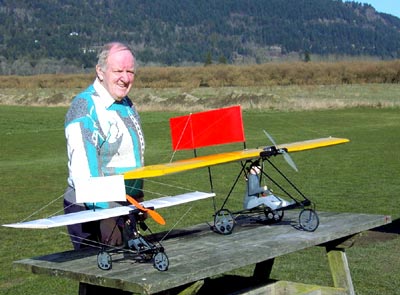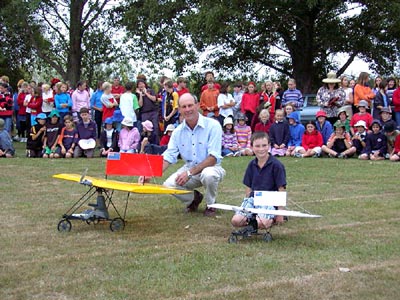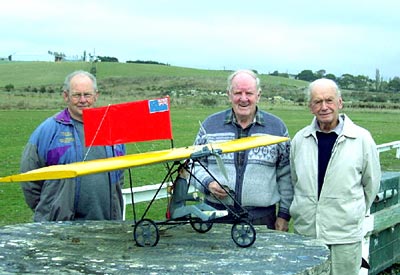|

Ivan Pettigrew is an
enthusiastic aeromodeller, specialising in electric RC. Here he is shown
with two of his Richard Pearse Monoplane models. He's made three in all,
these ones are Richard II and Richard III, which he bought with him to New
Zealand to partake in the centenary celebrations.
Ivan currently lives in Canada, but he was born and raised in New Zealand.
In fact, fifty years ago he was a junior teacher at Pleasant Point School,
which is located near Waitohi take-off site. His mother was an eight year
old girl growing up in the Waitohi, at the same time as Richard Pearse was
undertaking his flight attempts.

A few days before the
centennial celebrations, Ivan visited the Pleasant Point School and flew
his models for the school children there. Posing with Richards II and III
are Jeffrey Pearse (great-nephew of Richard Pearse) and his son Henry
Pearse (great-great-nephew of Richard Pearse).

This photo was taken at
the Waitohi take-off site. The threesome consists of Hec Sapwell (left),
who is one of the leading
modellers in Timaru and was on the planning committee for the
celebrations. In the middle is Ivan Pettigrew.
On the right is Richard Pearse (nephew of the inventor and father of
Jeffrey Pearse). Richard is the son of Warne Pearse, who was the only
family member to actually help the original Richard Pearse with his flight
attempts. Their closeness is perhaps why Warne named his son after him.


Here is some technical information about the models - Ivan writes that he
had:
"built three of
these models. The first one (Richard I) was a small park flyer, starting out with a
Speed 280 motor, but it was underpowered and rather unstable until I got
the C.G right. It has to be well forward. The result is that the nose
wheel has a lot more weight on it than desirable, so I have placed the
nose gear well forward. With this change, the landing roll is much safer,
with less tendency to do the 'wheelbarrow thing.' if not perfectly lined
up with the runway. Cross wind take offs and landings are not the best
because of such a short wheelbase, high C of G, and that fin being up so
high. But it makes for good stability in flight. I ended up with a geared
Speed 370 motor in this model, and eight 700 mAH NiMH cells. Span of this
first model is 36", chord 12" and flying weight with battery is 14.5 ozs.
It is
very aerobatic, better than the large one in fact, and will handle three
successive outside loops. It has has a flight endurance of over 10
minutes. NiMH cells are amazing in models of this size. This model has
three flight controls, aileron, elevator and rudder.
I found the fun of flying this little critter to be quite addictive, so I
made a larger 1/4 scale model with span 60" and chord 20 inches. This one
is referred to as Richard II. I made the wing in three equal sections of
20" square so that I could take it to New Zealand by fitting it in a
square box that conformed to the max size allowed by the airlines. The
rest of the components are all screwed together so that everything can be
taken apart. This model is powered by a 22 turn Magnetic Mayhem racing car
motor driving a 12 x 8 prop through a reduction gearbox. It is powered by
nine 1700 mAH nickel cadmium cells. Flight endurance is a good seven
minutes. Without the drag of the fat pilot it has flown 10 minutes. The
weight with the battery is 60 ounces.
I made a third model the same size as Richard I, but with removable wing
sections. This is Richard III. However, to save weight, I did not fit it
with ailerons. I had found that the models flew perfectly well with just
rudder and elevator. The only thing this model will not do is aileron
rolls."
|